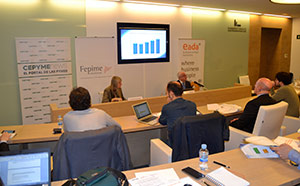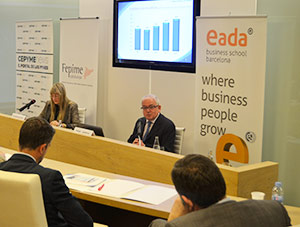8th Financial Diagnosis for Spanish Companies of EADA and CEPYME
Firm economic recovery of Spanish companies 
The EADA and CEPYME 8th Financial Diagnosis for Spanish Companies confirms the economic and financial recovery that national companies began to experience in 2015. According to the report, based on the analysis of 700 companies in different sectors and of varying sizes, all posted improvements concerning their main indicators. For example, corporate profitability rose 7%, the highest percentage since 2007. Additionally, in 2016 sales grew on average 3.7%, with the industrial sector particularly noteworthy, specifically large and medium-sized enterprises with rises of around 10%, unlike small and micro-enterprises, which only increased 3% and 2% respectively. Furthermore, 77% of companies made a profit, above all exporters, posting the highest figure since 2009.
In the financial sector, improved access to credit should be noted - in 2016 only 17% of companies had credit restrictions, lower than the 21% in 2015 and the 34% in 2014 - and defaults dropped for the fourth consecutive year, recording 3% for sales.
Further data highlighting the changing trends came in the generalization of business management measures more designed for the medium-term over the short-term. Whereas in 2012 and 2013, companies focused on reducing operating costs, personnel costs and lowering sales prices and margins to increase turnover, in 2016 their priority was medium- and long-term measures. Specifically, most focused their efforts on improving the product sales process, new product launches, business activities or lines and improving the stock purchasing price.
Factors of uncertainty
While there are reasons to be optimistic, Rafael Sambola, Finance professor and author of the study, warns that “business investments are still not enough to ensure sustained long-term growth.” Specifically, 62% of the companies consulted are not planning to invest, or if they are, it will be below depreciation.
He believes that “companies are thinking twice before investing, mainly because their priority is still to reduce their financial burden following the recent economic crisis.” However, he notes “they should take advantage of the low interest rates to kick start new investments, because it’s the only way to be sustainably competitive over time.” For SMEs and micro-companies, the EADA professor makes the case for “beginning M&A processes to guarantee this essential sustainable growth for boosting profitability. Along the same lines, Mª Helena de Felipe, CEPYME Vice-President and Fepime President, insists that “SMEs must increase these profitability ratios to enhance their productive capacity, gain in size and focus on other markets.”
Companies are thinking twice before investing, mainly because their priority is still to reduce their financial burden
 Another source of concern reflected in the report is the slower pace of recruitment despite greater economic dynamism. In fact, the percentage of companies planning to hire more staff this year is again 37%, like last year. The main constraints are “the lack of developing a streamlined industrial relations system that adapts to change and the lack of a lifelong-learning based culture.”
Another source of concern reflected in the report is the slower pace of recruitment despite greater economic dynamism. In fact, the percentage of companies planning to hire more staff this year is again 37%, like last year. The main constraints are “the lack of developing a streamlined industrial relations system that adapts to change and the lack of a lifelong-learning based culture.”
Rafael Sambola adds two further factors. On the one hand, “the problems of the Spanish labour market, with the highest levels of unemployment in Europe, which may become a structural issue, not a circumstantial one.” The other, “the destruction of 107,490 companies between 2008 and 2016, which can already be seen as the biggest cost of the financial crisis. He believes, “this cannot be repaired merely by promoting entrepreneurs, as this solution will struggle to cover the loss of experience, volume of employees and products offered by the old companies.”
Despite this uncertainty, the surveyed companies enter this financial year with better prospects than in 2016. For example, 67% forecast increased sales at the end of the 2017 financial year. They also confirm their commitment to developing new products and business lines and to invest more in their online presence.
